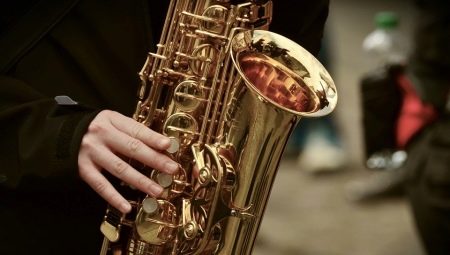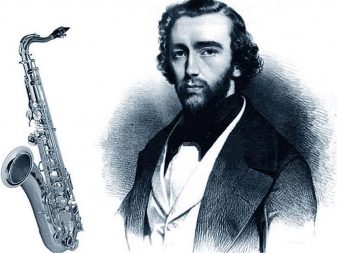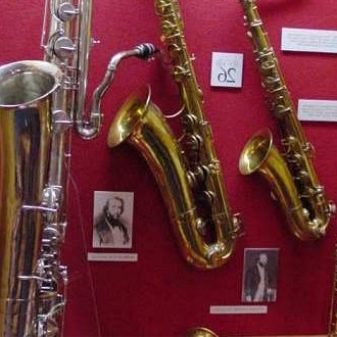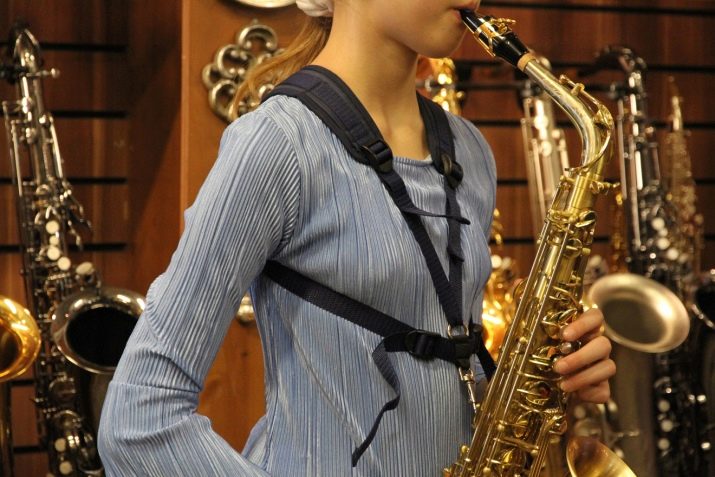What are saxophones and who invented them?

It is very important for music lovers to know what a saxophone is, how it looks and how it sounds. The designers have developed various variations of it - tenor and soprano, baritone and other types. In addition to such moments and the choice of a reed and a mouthpiece, it is necessary to familiarize yourself with a number of interesting facts.



What it is?
The saxophone is one of the prominent representatives of the woodwind family of woodwind instruments. This is a relatively new product - similar designs appeared only in the 1840s. The saxophone is used primarily in brass and symphony orchestras. But you can also solo with this instrument (with the accompaniment of a prepared orchestra or ensemble).
The device was developed by the Belgian specialist Adolphe Sachs, so we can confidently say that this is a “personalized” instrument. The saxophones are often played by jazzmen and members of similar musical genres. However, the instruments are quite applicable in pop music as well.
The advantages of this solution are associated with the impressive power of the structure and the fact that it provides a melodious timbre. In terms of technical mobility, there are practically no equals to such devices.



Structurally, they look like a cone-shaped tube. For its manufacture, use:
- brass;
- red brass;
- Pakfong.
The difference between tombak and pakfong is that the first alloy contains only copper and zinc, while the second also contains nickel. Any typical saxophone is made with a tube-like bend. But there are high models of the tool, which, due to the limited length, are not customary to bend.However, there are a number of experimental models that can be constructed in a variety of ways.


And yet, basically, the saxophone is divided into 3 constituent elements:
- trumpet;
- main building;
- a tube that continues this body, which received the common name "esca".
It is on the tube that the mouthpiece is placed, which is similar to the clarinet counterpart and in the same way resembles a beak. To obtain saxophone mouthpieces, the following can be used:
- plastic;
- black ebonite;
- metal.


Since saxophonists can play in different genres and styles, this detail is adapted to the desired sound. An important difference between her versions concerns the "mouth" and "notch". The first term refers to the distance separating the reed tip and the mouthpiece tip. The second is the length of the free area of the reed when pressed against the mouthpiece. The smaller the mouth, the better for classical compositions and the worse for other, more modern genres of music.
The reed part - the reed - is of key importance for the appearance of the desired sound. In terms of performance, it is easy to confuse it with a clarinet reed. The traditional approach implies that this part is obtained from reeds, reeds, bamboo. But for the sake of economy, synthesized materials are also actively used. In order for the reed to effectively interact with the mouthpiece, they are combined with a ligature mechanism; it's simple - just a small clamp and a couple of screws.


The classic saxophone design uses a metal ligature. But jazzmen and musicians of other genres prefer an instrument with a ligature part made of genuine leather. It allows the reed to wobble more freely. The cane can be severely damaged under various circumstances. Protective caps, which must be put on the mouthpieces of unused instruments, help to avoid this.
Any saxophone is equipped with 19-22 valves (depending on the type). This set of valves allows the body bores to close and open at the right time. The game consists of pressing and releasing individual keys on the keyboard at the right time.
Professionals do it easily and naturally. As a result, they manage to play even very complex melodies.


History of creation
As already mentioned, the creator of the saxophone is Adolph Sax, and the birthplace of this instrument is Belgium. Sachs was not an accidental person in the world of musical instruments - he had already worked in a special workshop for some time and even managed to obtain a number of patents. Sachs worked on an important problem at that time - how to eliminate the discrepancies in intonation that appeared between the instruments made of copper and instruments made of wood, common in brass bands. In the first third of the 19th century, the so-called ophicleid was already invented for this purpose.
But this development was not perfect enough and was too cumbersome; after 1850 it is used only in isolated cases. Meanwhile, the need to close the timbre gap between "copper" and "wood" was felt more and more persistently. And it was in the process of this search that Sachs invented his most famous creation.
The early saxophone appeared on public display in August 1841. Among the exhibits of the industrial exhibition in Brussels, he appeared under the name of "mouthpiece ophicleide" - since the developer himself did not at all seek to give the invention its own name.


That tool is known to:
- was made of metal;
- had a cone-shaped body;
- was completed with a mouthpiece with a single reed (minimally modified clarinet, in fact);
- possessed a set of Boehmian ring-shaped valves;
- was generally twisted.
It was not only the exhibition that helped Sachs to promote his product. He managed to take advantage of his friendship with Hector Berlioz, who warmly accepted all innovations in the musical field. And it was Berlioz who gave the instrument the name by which it is now known on all continents.It was first used in a newspaper article published by the composer on June 12, 1842. The role of Berlioz was not limited to this - he prepared the first piece in history intended to be performed on devices improved or created from scratch by the Belgian master, and in February 1844 he became the conductor at the premiere of the piece.


At the end of the same year, the saxophone made its debut in orchestral equipment, which performed the premiere of an opera by another author, and was also shown at the Paris industrial exhibition. In the spring of 1846, Sachs received a French patent for his musical instrument system. However, about a year earlier, saxophones, along with saxhorns, saxotubes were purchased by the French armed forces to replace obsolete musical instruments. Later, the former "mouthpiece ophicleide" continued to attract the minds of composers - mainly for thinking over opera productions. Symphonic works were accompanied by playing the saxophone much less frequently; thus, in Bizet's musical lineup for the dramatic production of "Arlesienne" there are two large fragments where the saxophonist is the soloist.
For 13 years, between 1857 and 1870, Sachs taught his instrument at the military department of the Paris Conservatory. This gave great results - many experienced musicians appeared, and composers paid more and more attention to saxophone music. However, during the Franco-Prussian War, the cadets were mobilized, and soon the training stopped completely.
True, the loss of interest in the saxophone in Europe was accompanied by the appearance of a number of good saxophonists on the other side of the Atlantic.


The following milestones:
- 1900 - 1920s - growing demand for the instrument among classical composers;
- the triumphant return of the saxophone to the big stage at the onset of the jazz era;
- 1969 - the beginning of the world congresses;
- 1995 - the creation of the European saxophone center (where all materials related to it are accumulated and studied, and also promoted the instrument).


Species overview
Sopranino
Initially, Sachs came up with 14 varieties of his instrument. But gradually, many were almost abandoned, and only 8 of them are actually widespread. Sopranino has the smallest size. Moreover, it is also characterized by the highest sound.
On sopranino, you can achieve a bright and soft timbre at the same time; this instrument is often used by musicians to perform lyric music, and its typical tuning is Eb.

Sopranissimo and soprillo
This is another type of mini saxophone. Such products are very rare. Usually they are 30 or 33 cm in length. The reason for the low prevalence is that it is very difficult to manufacture such devices.
It is only recently that the music industry has reached the point where it is possible to produce even small batches of soprillos.

Soprano
Such models are made with Bb tuning. There are both straight and curved body types. A characteristic feature is a high and shrill sound. But at the same time it is devoid of any loudness and rudeness. Soprano saxophones are in demand by both classical and pop musicians. Although they are relatively light in weight, and their dimensions are small, such a tool is not suitable for beginners.
Only those who confidently place their hands are good at playing the soprano saxophone. A well-designed ear cushion is also important. But there are exceptions to this rule. So, it is the soprano, and not the large instrument, that is most suitable for many children. Those cannot cope with larger products with their own hands - although you still have to pump breathing skills.


Alto
The sound of such a saxophone is most closely related to the Eb tuning. This option is considered the best for beginners to master the musical skills of adults and well-developed adolescents. Violas are compact and weigh relatively little.Their important advantage is the comfort of the keyboard and the "blow-off" methods. Another important advantage is the abundance of musical compositions, which allows you not to be limited to a narrow circle of melodies; that is why the viola is equally appreciated by both amateurs and skilled performers.


Tenor
In this case, the Bb tuning is characteristic. Such saxophones are only slightly less in demand than altos. They are larger, weigh more and are less ventilated. They have a lower but uniformly saturated frequency range.
Minor and major melodies are played with the help of the tenor, solo and accompanied by accompaniment.
The tenor saxophone is used by:
- academic orchestras;
- popular music performers;
- military musicians.


Baritone
This instrument has an Eb tuning. The main body is powerfully curved and folded almost in half. The so-called "esca" is wrapped in the manner of a loop. The sound is powerful and expressive depth, but this is achieved only in the middle and small register.
However, it is often noted that the hoarseness of the high register of the baritone saxophone is a very popular trait, including with military bands.


Bass and contrabass
The first subtype mainly uses the Bb tuning, while the second uses the Eb tuning. Such tools themselves are rare. Their characteristic feature is their very large size. Such saxophones can only be played by those who maximize their breathing and hone their technique. The sound both at the bottom and at the top of the range are about the same as that of a baritone, and even more pronounced.


According to the class of playing saxophones are divided into:
- training;
- elementary;
- professional levels.
The difference even concerns the materials used. Thus, a qualified musician is unlikely to play plastic models. He will carefully evaluate the ergonomics, appearance and sound quality. The cost of suitable modifications, respectively, will be higher. Some of the professional products are finished by hand after the end of the factory assembly.
The electronic saxophone is intended for beginners. It weighs less and is easier to learn. True, such products require a power source. Almost all of them are made of plastic. Professionals often view this technique with a slight tinge of contempt.


Components and accessories
These components are just as important as the tool itself. Basically, a case is included with the saxophone. In the absence of it in the set, it is useful to buy a wardrobe trunk separately.
The use of semi-rigid covers is recommended as a minimum. For long trips and check-in luggage, a hard plastic or even wooden trunk will come in handy at the hotel.

The belt, also known as Gaitan, will free your hands and simplify the game. The belt is rated for strength, width, comfort and adjustment. A useful addition is the mouthpiece cover. Silicone or rubber plate eliminates slippage of teeth along the surface of the mouthpiece. For both the teeth and the instrument, this sliding is not very beneficial, and it also provokes vibrations in the saxophone.

The cane is the main working part of the saxophone. It is selected according to the parameters of the mouthpiece. Mute also plays an important role - it provides a quieter and more relaxed game. Not only to avoid conflicts, but also to make it more melodic. The instrument microphone can be external or clip-on; the saxophone itself is not complete, of course, without a stand and stand.


Selection Tips
Choosing the best option for beginners is not as difficult as it seems. What should definitely be avoided are the largest specimens. Entry-level techniques are great for alto models. For adults, the tenor is sometimes better suited. It is imperative to evaluate the build quality and characteristics of the sound, which should be liked subjectively; experienced musicians sometimes even limit themselves to listening to the models they visually like.
The color is chosen purely to your liking. Of the saxophone parts, the mouthpiece is the most important.Be sure to check the tuning and ease of playing notes. If you plan to play certain music, take the instrument "for it".
It is useful to read reviews and consult with music teachers.


Technique of the game
You need to learn the fingering and subtleties of instrument adjustment as soon as possible. But to play properly, this is not enough. The first step is to extract sound from a mouthpiece that is not connected to a saxophone. Then the training will go easier. You cannot pinch the cane, closing it, but you also cannot let go of it.
Haste when playing the saxophone is unacceptable. If it is very difficult to get the sound "like a professional" - do as you can and gradually get closer to the correct breathing. You should not be afraid of unsuccessful attempts, but it is worth experimenting, remembering everything that happens. The mouthpiece is pulled out of the mouth only when the lips are relaxed. Air is inhaled through their edges, and they certainly do not open them wide, do not take breaths through the nose.
Recommendations:
- develop muscle memory;
- develop a clear attack on the syllable;
- master modern techniques (glissando, improvisation, multiphonic).

Nuances of care
An experienced saxophonist knows that it is better to clean the instrument one more time than to suffer from problems with it. As for the choice of lubricant, it is almost unlimited - it is definitely worth discarding only the cheapest options. Excess grease is removed with a napkin.
The eski socket is lubricated regularly, but to a minimum. For ligature screws, oils with dispensers are used.
When the game is over, you need to remove the moisture from the barrel. The main part is drained by turning the instrument over. Condensation is removed by rubbing with weights. For eski, a special, narrow wipe is needed. The cane is rubbed with dry cloth and placed in the saver, then the surface of the saxophone is wiped; besides that, the mechanics are lubricated every 5 - 6 months.

Interesting Facts
Many unusual details about the saxophone relate to its creator. That:
- repeatedly found himself on the verge of death in childhood (from an explosion of gunpowder, from a hot frying pan, from a stone hit on the head, from drowning in a river, from three consecutive poisonings with toxic fumes of drying varnish);
- worked on his first product (not yet a pure saxophone, but a modernized clarinet) from the age of 16 to 20;
- performed such complex melodies on it that after leaving the theater they had to be removed from the repertoire - they no longer obeyed anyone;
- in 1840 he received the gold medal of the Brussels exhibition and ... refusal to issue it due to excessive youth;
- at the exhibition in 1841 showed the first saxophone from behind the curtain to keep the know-how secret;
- 5 months before the receipt of the patent, he lost the court, which declared in the verdict “an instrument called the saxophone does not exist and cannot exist”;
- repeatedly faced with harassment - with bans on musicians to play saxophones, with slanderous articles and nasty cartoons;
- three times turned out to be bankrupt.


The Belgians are deservedly proud that the saxophone was created by their compatriot. When the country still had its own currency, the portrait of Adolphe Sachs adorned the 200-franc bill. But during his lifetime, as already mentioned, the master met with both delight and fierce hatred. Once they even tried to kill him. Today the giant Sachs monument and the museum dedicated to it are located in the city of Dinant.
On the streets of Dinant, symbolic images of a saxophone can be seen on any building. It is also found in many logos. There is a monument to the saxophone in Rostov-on-Don.
Saxophonist Escalante managed to keep 1 note for 90 minutes. Every year a commemorative event is held in honor of the designer.










